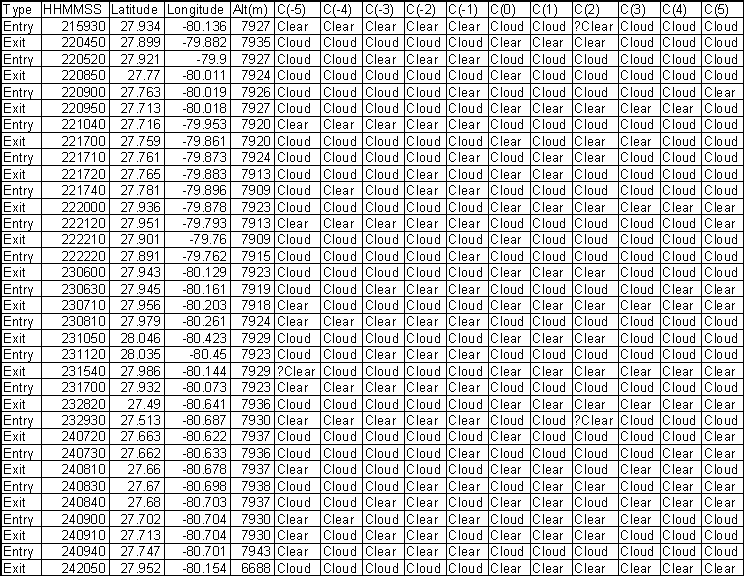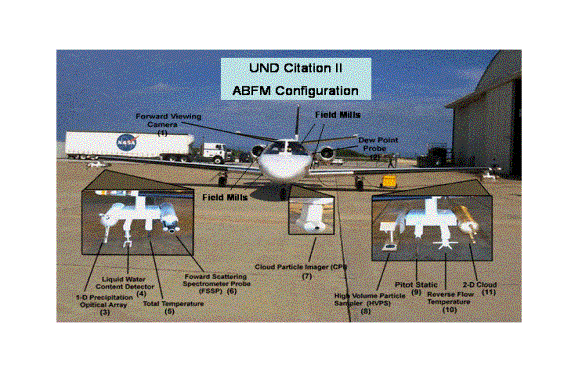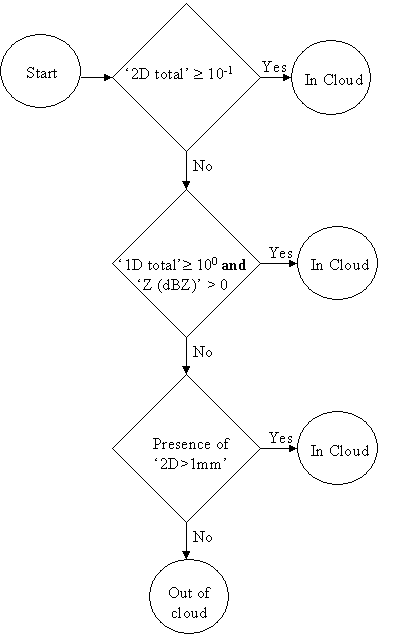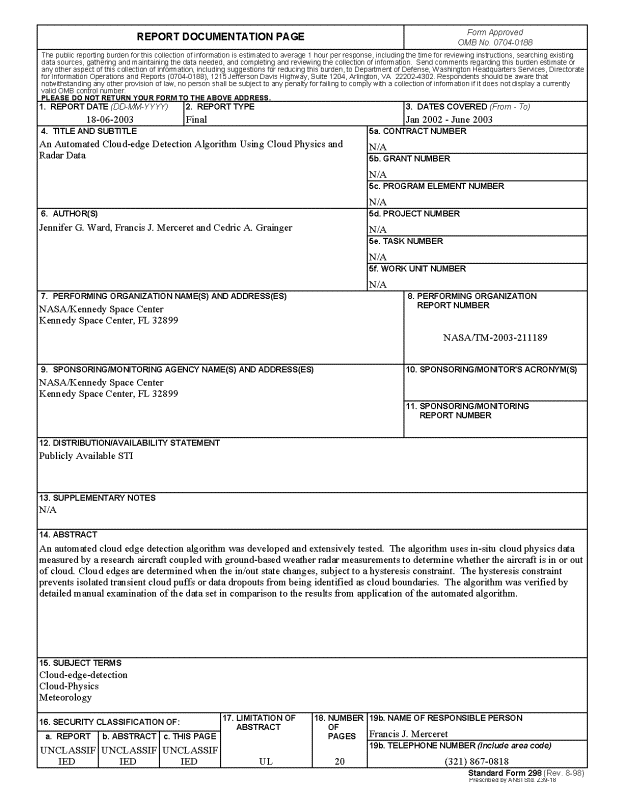Introduction
Beginning in 1999, the Kennedy Space Center sponsored an
Airborne Field Mill (ABFM) experiment in support of its Lightning Launch Commit
Criteria (LLCC) project. The LLCC
project is designed to improve the weather constraints (launch commit criteria)
designed to protect space launch vehicles, including the Space Shuttle, from
natural and triggered lightning. If
these constraints are violated, launch must be delayed or scrubbed until the
weather improves. The first ABFM field
campaign took place in June 2000 (Merceret and Christian, 2000). A second field campaign of this project was
conducted in February 2001 and a third in May-June 2001 for a total of 30
flight days.
The goal of the LLCC project is to use the ABFM measurements
to learn enough about the behavior of electric charge in and near clouds to
safely relax the current LLCC. Although
the current constraints are safe, they have a false alarm rate (rule violated
when it would actually be safe to fly) of more than 90 percent in some cases
(Hugh Christian, NASA/Marshall Spaceflight Center, private communication). This is due primarily to our ignorance of
how charge behaves in the atmosphere compounded by the need for large margins
to ensure safety where there is no room for error The LLCC project is directed at reducing the ignorance component
of this situation so that less restrictive yet even safer rules may be developed.
A key component of the experimental design is to couple
ground-based weather radar measurements with in-situ cloud physics and
electric field measurements from an instrumented aircraft. Details are presented in Merceret and
Christian (2000).
A first step in understanding charge behavior is collecting
accurate estimates of electric field decay as a function of distance from the
cloud boundary. Because of the massive amount of data collected throughout the
project, an automated system for identifying the cloud edges was essential. The
cloud edge detection algorithm has two components: an in-cloud detection
component and a boundary detection component.
The in-cloud component relies on cloud physics data from the research
aircraft as well as ground-based weather radar data. Details of the instrumentation are given in the Appendix. The boundary detection component examines
the output of the in-cloud algorithm and applies a hysteresis test to avoid
false boundary detections due to momentary fluctuations in the data. This paper
describes the development and end-to-end testing of the complete algorithm.
1. Methodology
The National Center for Atmospheric Research (NCAR) provided
ASCII format files containing time synchronized and quality controlled values
at ten-second intervals for the following variables used to develop this
algorithm:
- Cloud
particle concentration (per liter)
- Radar
reflectivity at the aircraft position (dBZ)
Many other variables were provided in the data files, but
they were not used to develop the cloud edge detection algorithm and will not
be discussed in this paper.
In addition to the ASCII files, NCAR provided time
synchronized constant altitude radar maps (CAPPI) with the aircraft track
overlaid (e.g. Figure 1) and simultaneous time series plots (MER) of all
of the above variables in the format shown in Figure 2. MER is an acronym for microphysics, e-field
and radar.

Figure 1. Constant Altitude Plan Position Indicator (CAPPI)
plots at 4, 8 and 10 km for 1815 to 1820 UTC on 24 June 2001. The aircraft
track during this period is superimposed on the radar data.

The MER and CAPPI plots were manually examined for each of
the 30 days in the ABFM data set. A list of each entry into or exit from cloud
was compiled with the time of the transition estimated to the nearest ten
seconds. At the same time, the behavior
of the cloud physics measurements was noted. A tentative relationship between
these variables and the analyst's judgment regarding the presence or absence of
cloud was formed. This judgment was refined by more detailed examination of
each cloud boundary transition until the algorithm presented below for
determining whether cloud was present was formulated.
Next, the algorithm was coded and run without manual
intervention on just the ASCII data.
The results were compared with the manual analysis. In most cases, the results were identical. In those cases where there were
discrepancies, further analysis proved the automated algorithm to be
correct. This will be discussed in the
results section below.
Once the reliable method of determining in vs. out of cloud
was complete, the remaining task for automated boundary detection was to
incorporate some way of handling fluctuations at cloud edges to avoid rapid
cycling in wispy cloud fragments at the cloud boundary. This was accomplished with a hysteresis
check also described below. These two elements, cloud detection and hysteresis,
compose the cloud edge detection algorithm. Comparison of the manual and
automated cloud edges was used to select the appropriate hysteresis threshold.
Part 2. The Cloud
Presence Component
Upon examining the MER plots, it became apparent that if the
Particle Measuring System (PMS) 2D Cloud Probe ‘2D total’ was > 10-1
per liter then the aircraft was in cloud. There were frequent cases where
the ‘2D total’ was < 10-1 per liter but there was cloud present.
In order to diagnose these cases, the PMS 1D Cloud Probe ‘1D total’ was
examined along with the radar reflectivity at the aircraft ‘Z (dBZ)’. If the 1D
probe was > 100 per liter and the radar reflectivity was
> 0 dBZ then the aircraft was in cloud. If neither of the above indicated
the presence of cloud, the presence of any large particles on the PMS 2D probe,
‘2D>1mm’, would indicate that the aircraft was in cloud. Otherwise, the
aircraft was out of cloud. Because this algorithm was created for anvil and mid
to high-level clouds, it is possible for a false "in cloud" reading
to occur in some circumstances such as low level flight in precipitation.
The following flow chart shows the algorithm.
Part 3.
Hysteresis Component
Since the goal of locating cloud boundaries for this project
is to examine the variation of electric field with distance from cloud edge, it
is essential to isolate true boundaries of significant clouds. Unfortunately, small wisps of cloud in
otherwise clear air will be designated as "in cloud", and small gaps
in otherwise solid cloud masses will be designated as "clear" by any
local automated cloud detection algorithm.
These designations are not erroneous, but neither are they desirable for
finding the true edge of nearly continuous cloud masses.
The solution we have adopted is to only use "clean"
cloud boundaries in our data set. A
clean boundary is a cloud boundary with two additional constraints, called
"hysteresis" constraints.
There are four steps in the process. Unless all four steps are
satisfied, there is no cloud edge as defined by this algorithm. In the steps
listed below, a "record" refers to one line of ten-second data in a
data file. Each line contains the ten
second average of each of the measured variables along with the position and
attitude of the aircraft and the time of day.
The syntax Record(I).x is used to indicate the value of variable x in
record(I) where I is the sequential record number.
- Examine
the current record (I) for a transition from cloud to clear or clear to
cloud. A transition is present if Record(I).InCloud XOR
Record(I-1).InCloud is true.
InCloud is a boolean record variable that is TRUE if the in-cloud
component of the algorithm is satisfied as described in the previous
section.
- If a
transition has occurred, examine the previous 20 records to locate how many
records (JMinus) back the immediately previous transition occurred. A
previous transition is present at record (I- J) if Record(I-1).InCloud XOR
Record(I-J-1).InCloud is true. If
no transition is found, JMinus is set to 20.
- If a
transition has occurred, examine the next 20 records to locate how many
records (JPlus) ahead the next transition occurs. Another transition is
present at record (I+ J) if
Record(I).InCloud XOR Record(I+J+1).InCloud is true. If no transition is found,
JPlus is set to 20.
- Both
JPlus and JMinus must be greater than or equal to a user-selected value,
H, between 0 and 10.
Selecting H = 0 turns off all hysteresis testing and locates
all boundaries, however evanescent.
Setting H=N assures that at least N continuous records of the same kind
(in cloud or clear) exist on each side of the boundary.
For the ABFM program, the records are spaced 10 seconds
apart. The true airspeed of the
research aircraft ranged from 100 - 130 m/s.
Thus, the value of H is approximately the length in kilometers of
cloud/clear continuity required on each side of the cloud edge for that
transition to be included in the analysis data set. Values of H ranging from 0
to 10 were tried on sample days. H=2
most closely matched the manual analysis of cloud boundaries. H<2 included transitions due to data
dropouts and small puffs of cloud undetectable on radar. Data dropouts can occur for a variety of
reasons including instrument anomalies, recording system failures, power bus
transients and operator error. H>2 eliminated transitions significant enough
for the analyst to list them.
Part 4. Data
verification
Once the “in-cloud” rule was devised and the hysteresis
concept developed, code was created and the data set was processed. A sample of
part of the program output is shown in Table 1. The columns labeled C(N) contain the algorithm's evaluation of
whether the aircraft was in cloud or in the clear at time N from the cloud
boundary detected by the algorithm. N
ranges from -5 to 5 where each unit corresponds to ten seconds of flight. This unit was selected for two reasons. First, the data were available at ten second
intervals, so N corresponds to the number of records from the boundary. Second, the aircraft speed was about 100 m/s
so each unit is approximately 1 Km of distance. If all of the data required to determine the presence of cloud
were flagged by the automated QC process as suspect, the designation
"?Clear" appears in the table.

Table 1. Example of output from automated cloud-edge detection
algorithm with H=0.
This was compared to the manual cloud detection spreadsheets
completed beforehand. The results showed all of the manual entry/exit points
had been picked up by the software as well as some additional points. These other points were examined more
closely and determined to be correct. The reason for their being overlooked in
the manual process was because all of the transitions missed were less than 20
seconds and many appeared near the edge of the MER plots so that they appeared
to be artifacts of the plotting process. For this reason a hysteresis of 2 was
chosen as the optimum one. In the full data set, the manual process found 1014
entry/exit transitions while the automated algorithm found 1269.
Part 4.
Conclusion
An automated process for identifying cloud boundaries in
airborne cloud physics data with accompanying ground based radar was developed
and tested. It performed slightly
better than manual analysis on an extensive data set from the Airborne Field
Mill Program. It will permit automated
analysis of the variation of electric field and radar reflectivity with
distance from cloud edge. It can also
be used to automate stratification of data depending on cloud presence for
statistical analysis. Both of these functions
are extremely labor intensive when performed manually. The automated algorithm is expected to
reduce the labor required for the target analyses by more than 75%.
References
Merceret, F.J. and H. Christian, 2000: KSC ABFM 2000 - A Field Program to
Facilitate Safe Relaxation of the Lightning Launch Commit Criteria for the
American Space Program, Paper 6.4, 9th AMS Conference on Aviation and Range
Meteorology, Orlando, Florida, 11-15 September 2000.
Merceret, Francis J. and Jennifer G. Ward, 2002: Attenuation
of Weather Radar Signals Due to Wetting of the Radome by Rainwater or
Incomplete Filling of the Beam Volume, NASA Technical Memorandum
TM-2002-211171, April 2002, 16pp.
Short, D.A. (2000): Final Report on IRIS Product
Recommendations, NASA Contractor Report CR-2000-208572, Applied Meteorology
Unit, ENSCO, Inc., 1980 N. Atlantic Ave, Cocoa Beach, FL 32931, 26 pp.
APPENDIX A – Instrumentation
UNIVERSITY OF NORTH DAKOTA
CESSNA CITATION II RESEARCH AIRCRAFT
Introduction
The University of North Dakota owns and operates a Cessna
Citation II aircraft (N77ND) for the purpose of atmospheric research. This
aircraft type has a number of design and performance characteristics that make
it an ideal platform for a wide range of atmospheric studies. The Citation II
is a twin-engine fanjet with an operating ceiling of 43,000 feet (13.1 km). The
turbofan engines provide sufficient power to cruise at speeds of up to 340
knots (175 m s-1) or climb at 3300 feet per minute (16.8 m s-1).
These high performance capabilities are accompanied by relatively low fuel
consumption at all altitudes, giving the Citation an on-station time of up to 4
hours or more, depending on mission type. Long wings allow it to be operated
out of relatively short airstrips and to be flown at the slower speeds (140
kts/72 m s-1) necessary for many types of measurements. The Citation
is certified for flight into known icing conditions.
The cabin measures approximately five feet in diameter and
more than 16 feet in length. The minimum flight crew is pilot, co-pilot and
data system operator. Two additional seats are available for scientific
observers or additional instrumentation specialists.
A series of structural modifications have been made to the
basic airplane. These include the following: pylons under the wing tips for a
variety of probes in the undisturbed air flow away from the fuselage; a heated,
5-port radome for wind measurement; and an air inlet port and manifold for air
sampling inside the pressurized cabin. A summary of the operating
characteristics of the aircraft is given in Table A1.
Table A1
Operating Characteristics of the
Citation II
|
Ceiling
|
13.1
km
|
(43,000')
|
|
Endurance
(plus reserves)
|
up to 4.5 hours
|
|
|
Empty Weight
(including
Std. instrumentation)
|
3888 kg
|
(8554 lbs)
|
|
Max Takeoff Weight
|
6591 kg
|
(14,500 lbs)
|
|
Range (not including
reserves)
|
2500 km
|
(1350 nm)
|
|
Top Speed (True air
speed, in research configuration)
|
630km h-1
|
(340 kts)
|
|
Typical Sampling Speed
(indicated)
|
80 m s-1
|
(160 kts)
|
|
Fuel Consumption
(Typical cruise configuration)
|
362 kg h-1
|
(800 lbs h-1)
|
|
Time to Climb from Sea
Level to 3.0 km at Max Takeoff Weight
|
4 min
|
|
|
Time to Climb from Sea
Level to 7.6 km (25,000') at Max Takeoff Weight
|
13 min
|
|
|
Time to Climb from Sea
Level to 10.7 km (35,000') at Max Takeoff Weight
|
24 min
|
|
|
Takeoff and Landing
Distance (most airports)
|
less than 1.9 km
|
(6000')
|
|
Total Power Available
for Instrumentation
|
450A at 28 VDC
|
|
|
Research Power
Available
|
35A 60 Hz
15A 400 Hz
160A 28 VDC
|
|
The research instrumentation configuration used during the
ABFM is listed in Table A2. The Instrumentation is described in more detail in
Table A3. Typically, the equipment carried on any given research project will
differ somewhat from the description given here. The installation of
instruments provided by other investigators can be accommodated, subject to
space, weight and electrical requirements. A variety of 19-inch racks are
available to accommodate standard instruments. A picture of the aircraft as configured
for the ABFM program is shown in Fig. A1.
Meteorology
The basic
instrumentation package measures temperature, dew point temperature, pressure,
wind and cloud microphysical characteristics along with aircraft position,
attitude and performance parameters. The three-dimensional wind field is
derived from measurements of acceleration, pitch, roll and yaw combined with
angles of attack and sideslip and indicated airspeed. The aircraft parameters
are supplied by an Applanix POS-AV strap-down gyro system with integrated
global positioning system (GPS). Strap-down accelerometers provide lateral and
longitudinal aircraft accelerations. Turbulence intensity can be derived from
differential pressure transducers and accelerometer outputs. Cloud microphysical
measurements are made with an array of Particle Measuring Systems probe s
(FSSP, 1D-C, 2D-C) mounted on the wing-tip pylons. These probes measure
concentrations and sizes of particles from one micrometer to several
millimeters in diameter. In addition, there are probes to measure both liquid
water content and icing rate.
For the ABFM project, an array of six electric field mills
was installed on the aircraft. Four of these mills were located just aft of the
cockpit and two more near the tail of the airplane. The output from these
mills, when put into a solution matrix, yielded the three components of the
electric field relative to the aircraft.
Remote Sensors
A forward or
side-looking video camera is also used to provide a visual record of flight conditions.
A Bendix-King vertical profiling forward-looking weather radar can be viewed in
the cockpit and recorded on videotape.
Data Acquisition and Display
The data are sampled at various rates from 4 to 200 sec-1.
The sampling is controlled by the on-board computer system, which also displays
the data in real time in graphic and alphanumeric formats while recording them
on magnetic tape. The data can also be telemetered to a ground station and
displayed in real time, or data may be telemetered from the ground to the
aircraft. The data system is based on a project-customized windows system to
allow flexibility in data acquisition and instrumentation in order to
accommodate specific research demands.
Air Parcel Tracking
The data system can also run a "pointer" algorithm
that can be set to track the three-dimensional advection of up to three
separate air parcels. This allows the aircraft to sample in a Lagrangian frame
of reference.
Field Support
When in the field, the Citation is accompanied by a mobile operations
support trailer. This vehicle houses technical support facilities, including
calibration equipment for on-site quality control, and computer systems. The
meteorological data collected on a research flight can thus be processed and
examined within a few hours.
Table A2
Summary of Measurement Capabilities as used in ABFM
State Parameters
Temperature Rosemount
Total Temperature
Dew Point Temperature
EG&G Cooled
Mirror
Static Pressure Rosemount
Cloud Microphysics
Cloud Droplet Spectrum PMS
FSSP
Cloud Particles PMS
Optical Array 1D-C
Cloud Particles PMS
Optical Array 2D-C
Cloud particles SPEC
Cloud Particle Imager
Precipitation Particles SPEC
HVPS
Liquid Water Content PMS
King
Supercooled LWC Rosemount
Icing Rate Meter
Air Motion and Turbulence
Horizontal, Vertical Wind Ported
Radome, Applanix
POS
Attack and Sideslip Angles, Ported
Radome, Differential
Airspeed Pressure Transducers
Aircraft Parameters
Heading, Pitch, Roll, Applanix
POS-AV Strap-down
Ground Speed,
Position, Gyro and Accelerometers with
Vertical
Acceleration integrated GPS
Cabin Pressure Setra
Electric Fields
Electric Fields Six
NASA Electric Field Mills
Table A3
UND
Citation Instrumentation Specifications
|
Parameter
Measured
|
Instrument
Type
|
Manufacturer
&
Model #
|
Range
|
Response
Time
|
Accuracy
|
Resolution
|
|
Temperature
|
Platinum
Resistance
|
Rosemount Model 102 Probe
|
-65°C to +50°C
|
1 s nominal
|
0.5°C
|
0.03°C
|
|
Dew Point
|
Cooled Mirror
|
EG&G Model 137
|
-50°C to +70°C
|
2°C S-1
|
0.5°C>0°C
1.0°C<0°C
|
0.03°C
|
|
Static Pressure
|
Absolute Pressure
|
Rosemount 1201F1
|
0 to 1034 mb
|
15 ms
|
3.1 mb
|
0.25
mb
|
|
Altitude
|
GPS
|
Applanix
|
0 to 20 km
|
10 msec update
|
0.1 km
|
1 m.
|
|
Attack Angle
and Sideslip
|
Differential Pressure
|
Validyne P40D
|
34.5 mb
|
20 ms
|
0.09
mb
(0.05°)
|
0.02
mb
(-0.01°)
|
|
Indicated
Airspeed
|
Differential Pressure
|
Rosemount 1221F
|
0 to 172 mb m-2
|
10 ms
|
"0.55
mb
(0.8 m s-1)
|
0.04
mb
(-0.06 m s-1)
|
|
Heading
|
POS
|
Applanix
|
0-360°
|
10 ms update
|
12 arc
min
|
6 arc
min
|
|
Pitch, Roll
|
POS
|
Applanix
|
-90° to +90°
|
10 ms update
|
2 arc min
|
0.25
arc min
|
|
Vertical Acceleration
|
POS
|
Applanix
|
-10 to 30 m s-2
|
42 ms
|
0.1 m
s -2
|
0.01 m
s-2
|
|
Lateral, Longitudinal Acceleration
|
POS
|
Applanix
|
5.0 m s-2
|
10 ms
|
0.1 m
s-2
|
0.002
m s-2
|
|
Ground Speed
|
POS
|
Applanix
|
0 to 500 m s-1
|
10 ms update
|
0.5 m
s-1
|
0.05 m
s-1
|
|
Position
|
POS
|
Applanix
|
90° Lat
180° Long
|
10 ms update
|
0.1 km
|
1 m
|
|
Liquid
Water Content
|
CSIRO
Liquid Water Detector
|
PMS
|
0-9 g
m-3
|
0.05 s
|
5%
|
0.005
g m-3
|
|
Icing
Rate
|
Vibrating
Cylinder
|
Rosemount
Model 871FA
|
0-0.0251
cm before recycle
|
7 s
recycle
|
±.013
cm
|
0.003
cm
|
|
Cloud
Droplet Spectrum
|
Forward
Scattering Spectrometer Probe
|
Particle
Measuring Systems (PMS)
FSSP-100
|
0.5-47mm
|
4 Hz
sampling
|
-
|
0.5-3.0mm
variable
|
|
Cloud
Particles
|
Optical
Array Probe 1D-C
|
PMS
OAP-230X
|
20-600
mm
|
4 Hz
sampling
|
-
|
20 mm
|
|
Cloud
Particles
|
Optical
Array Probe 2D-C
|
PMS
OAP-2DC
|
30-960 mm
|
4 Hz sampling
|
-
|
30 mm
|

Figure A1. The UND
citation with LLCC/ABFM instrumentation
APPENDIX B – Weather Radar
Two weather radars were used in this project, the National
Weather Service WSR-88D (NEXRAD) at Melbourne, Florida and the Air Force
WSR-74C at Patrick AFB, Florida. Except
in a few cases where the aircraft was in the cone of silence of one of the radars,
or where attenuation due to precipitation was a concern, the two instruments
provided equivalent data.
The NEXRAD is a ten cm Doppler radar located at 28.11N and
80.65W at an elevation of 35 ft.
NWS/MLB personnel recorded full volume scan data specifically for the
ABFM program in real time on a dedicated 4mm DAT system supplied by the Applied
Meteorology Unit. These data were processed at NCAR using custom software to
translate them to a 1x1x1 Km three-dimensional grid of reflectivity. The
gridded data were used in this study.
The beam width and scan strategy for this radar are described in Short
(2000). All missions flown during the
ABFM field program were within 200 Km of the radar. Attenuation of the radar signal due to rainfall on the radome or
between the radar and the aircraft was not significant at any time for this
radar.
The WSR-74C is a five cm conventional radar located at
28.26N and 80.66W at an elevation of 65 ft. Eastern Range Technical Services
Contractor personnel recorded full volume scan data specifically for the ABFM program
in real time. These data were also processed at NCAR using custom software to
translate them to a 1x1x1 Km three-dimensional grid of reflectivity. The
gridded data were used in this study.
The beam width and scan strategy for this radar are also described in
Short (2000). All missions flown during
the ABFM field program were within 200 Km of the radar. Attenuation of the radar signal due to
rainfall on the radome or between the radar and the aircraft was significant at
times for this radar (See Merceret and Ward, 2000, for a complete discussion of
wet radome attenuation). When
attenuation was not negligible, the data were not used.
![]()







